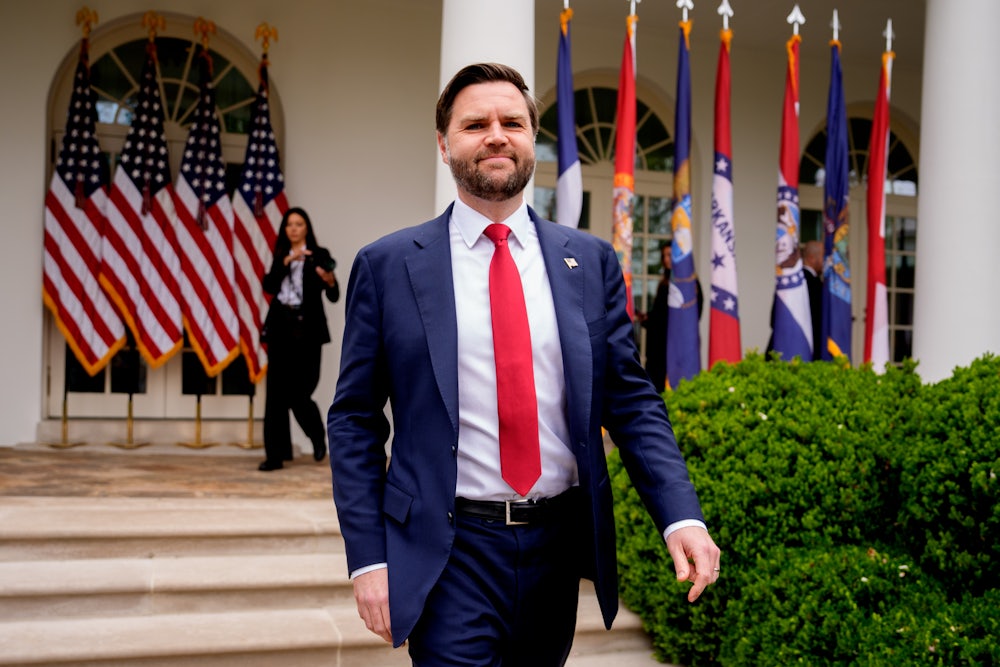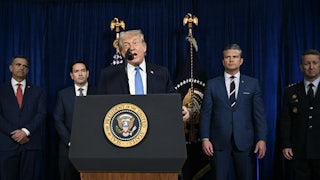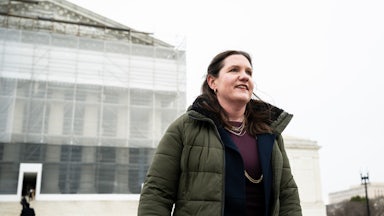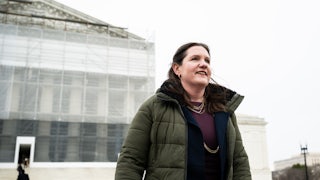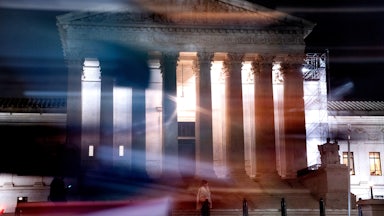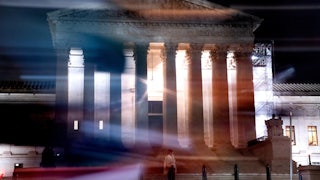In late March, a group of Republicans in California sparked controversy for their plan to host an event dubbed “A Normal Gay Social.” The party referenced something JD Vance said before the 2024 election: “I wouldn’t be surprised if me and Trump won … the normal gay guy vote,” Vance told podcast host Joe Rogan, “because they just wanted to be left the hell alone.” Normal gays, he explained, opposed “crazy stuff,” like prescribing puberty blockers to transgender minors.
In the end, Trump drew only 12 percent of the LGBTQ vote, a two-point drop from 2020 and 10 points lower than Mitt Romney in 2012. Yet Vance’s remarks highlight the GOP’s seemingly contradictory relationship to queer citizenship. While there is a long history of gay, lesbian, and transgender conservatives, national Republican candidates tend not to acknowledge them. Furthermore, the GOP has aggressively pushed sexual and gender minorities out of public life with bans on books, Pride celebrations, school curricula, and transgender therapies. Legislative efforts to ban, or render meaningless, the chief marker of “normality”—gay marriage—are moving forward in Michigan and several other states.
Last week, the Supreme Court heard arguments in Mahmoud v. Taylor, a case that has generated media coverage for the way it foregrounds Maryland parents from diverse faith traditions who do not believe that LGBTQ people are normal. They do not wish their children to know about them, and they contend that “compelling their elementary-age children to participate in instruction contrary to their parents’ religious convictions” violates their First Amendment rights.
At the same time as Mahmoud expresses one tendency of the MAGA coalition, it is in tension with another consensus that reaches across the political spectrum: that gay people can and have a right to be normal—to marry, raise children, and have access to full rights. Vance’s speculation that there was a gay GOP vote to be had was jolting to liberals, who see the Democratic Party as the home of LGBT rights.
But it didn’t surprise gay Republicans, who have worked to balance their sexual identities with other identities—as businessmen, parents, politicians, and people of faith—since the 1950s.
Knowing who “normal gays” are, and why some of them would vote for a party that has LGBTQ rights in its crosshairs, reveals a little-explored convergence between the histories of sexual citizenship and the American political right.
Cold War culture prized normalcy, particularly in the realms of sex and domesticity. On the one hand, this marginalized lesbians and gays; on the other, it created an obvious path to full citizenship. The task was formidable but clear: The state regarded them as criminals, the church as sinners, and the medical profession as sick. As small groups of activists began to organize as “homophiles” in the 1950s, they set their sights on a single goal: being left alone. Working with lawyers, psychiatrists, and faith leaders, they sought to persuade the courts and the public that being gay was one variation of normal, human sexuality.
Not surprisingly, perhaps, the idea that the state should interfere with Americans’ private sex lives was particularly offensive to libertarian and conservative homophiles. Post–World War II organizations like the Mattachine Society and the Daughters of Bilitis urged their networks of members to adopt conservative styles and to embrace middle-class respectability as proof they were normal and deserved rights. They rejected gender-bending working-class bar cultures, fought for the decriminalization of gay sex, and emphasized their right to privacy and free speech.
Ironically, this strategy also made normal gays a target. Throughout the Cold War, government officials like FBI Director J. Edgar Hoover and Christian anti-Communists warned Americans that gays and lesbians were especially subversive because they seemed normal. In “Boys Beware,” a short film produced by one school district, a police officer warns that “a homosexual has a sickness that is not visible like smallpox.”
Yet, as a political strategy, striving for normalcy was effective in overcoming manufactured stigma. The Mattachine Society cultivated ties to established religious figures, and One, Inc. won a landmark lawsuit declaring that homosexuals were not inherently obscene. The visual iconography of protests also deliberately drew on African American respectability politics. The Daughters of Bilitis instructed members in feminine self-presentation, while at the Annual Reminders, a yearly picket held at Philadelphia’s Independence Hall in the 1960s, organizers required appropriately gendered business clothes.
As activist Frank Kameny, one of the event’s leaders, noted, homosexuals should look “employable.” Americans soon learned that many gays already worked in “normal” occupations. In 1975, Air Force Sergeant Leonard Matlovich—Bronze Star recipient, conservative, and an outspoken Roman Catholic—launched a campaign to serve openly in the military, appearing on the cover of Time magazine as the face of “the gay drive for acceptance.” That same year, retired NFL running back David Kopay also came out as gay.
As municipalities began to concede civil rights protections demanded by LGBTQ activists, the backlash was predictable: Heterosexual conservatives mobilized to take back normality. “Once legislation is turned around to support and to flaunt the abnormal,” Christian singer Anita Bryant told reporters on the eve of a successful 1977 referendum to retract gay civil rights in Miami, “rather than to protect the normal, then our nation is gone.” John Briggs, a Republican state senator from Orange County, California, agreed. In 1978, Proposition 6, which would have made it illegal for any gay or lesbian person to teach in public schools, told “homosexuals” that California would not “accept you are normal people, because you are not normal people.”
Gay rights leaders convinced Californians to reject the Briggs Initiative, but less than five years later, the HIV/AIDS crisis ripped through gay male communities, reviving long-held prejudices about homosexuals as degenerate, undisciplined, and diseased. If radical LGBTQ activists put queer stigma at the center of transformative organizations like ACT-UP, liberals and conservatives argued that sex radicalism was the problem to begin with. As conservative Catholic journalist Andrew Sullivan argued in this publication in 1989, gay marriage was the answer. Homosexuality was “normal”: a natural, involuntary condition that required access to mainstream institutions, discipline, and responsibility—not special rights.
Like military service, legal marriage was not a new concept for many gays and lesbians who had been married or lived in long-term domestic partnerships. It could be a gateway to normality and to specific rights like child custody, decriminalized sex, and financial security. By the 1990s, it seemed possible. If George H.W. Bush could still maintain in his losing 1992 campaign that homosexuality “in my view is not normal,” popular culture had begun to disagree. Network television shows like The Real World (1994), My So-Called Life (1994), and Will and Grace (1997) brought lesbian and gay people into American living rooms as friends and sympathetic characters.
Gay marriage had material and cultural benefits; it was a normalizing institution that opened the door to all forms of normality. “I want gay kids to grow up believing that they can get married, that they can join the Scouts, that they can choose the life they want to live,” liberal Harvard Law grad and Lambda Legal Defense attorney Evan Wolfson told the Washington Blade in 2001.
On June 26, 2015, that dream came true. As Associate Justice Anthony Kennedy, a conservative Reagan appointee and author of three other landmark gay rights cases, wrote for a 5–4 majority, the children of LGBTQ couples deserved the respectability conferred on normal families. “Without the recognition, stability, and predictability marriage offers,” Kennedy wrote, “children suffer the stigma of knowing their families are somehow lesser.… The marriage laws at issue here thus harm and humiliate the children of same-sex couples.”
Seventeen months later, Donald Trump was elected president of the United States.
Not unexpectedly, Trump has consistently distanced himself from homophobia, if not the anti-trans politics that animate the national Republican culture war. He is a New Yorker, was mentored by right-wing gay attorney Roy Cohn, and has gay friends. Vance, an Augustinian Catholic who famously broke with a transgender friend when he pivoted to Trumpism, also has close relationships with “normal gay guys” who “want to be left the hell alone.” His chief funder for the 2022 Ohio Senate race was his former boss, tech billionaire Peter Thiel, an unapologetically gay man who intentionally bankrupted the website Gawker for printing rumors about his private life.
These friendships and financial relationships have followed both men into the White House. Openly gay Apple CEO Tim Cook gave $1 million to Trump’s inauguration committee. Scott Bessent became the first out secretary of the treasury. Foreign policy adviser Richard “Ric” Grenell is a first-term alum, while Vince Micone, a 30-year civil service veteran, is now deputy secretary in the Department of Labor. All are white, straight-looking, and discreet. While Micone appears to be single, Scott Bessent is married with two children born through surrogacy; and Grenell, a Christian who opposes gay marriage, has a longtime domestic partner.
These men are not anomalies. They draw on a long conservative tradition of “normal gays” who may make some on the GOP uncomfortable but seem to perceive their sexuality as a private and largely incidental matter. They also embody the contradictions of that tradition, shielding Trump from culpability for state GOP initiatives, conservative culture wars, and cases like Mahmoud that push LGBTQ people back in the closet and elevate conservative Christianity as the standard for “normal” personhood. We see this tension arise frequently in the MAGA GOP: While the 2024 national Republican platform seemed to soften the party’s stance on gay marriage, that same year the Texas GOP platform declared homosexuality “an abnormal lifestyle choice.”
Trump’s policies also draw on this tradition by aggressively defining who “normal gays” are not: trans. Among other initiatives, the administration is suing Maine for including trans youth in school athletic programs. It has ordered trans soldiers to be dismissed from the military and edited trans people out of the National Parks Service page devoted to New York’s iconic Stonewall Inn.
But lesbians and gays are also being edited out of American history more generally. In one much-mocked move, a photograph of the Enola Gay—a plane named after the pilot’s mother and used to drop the first nuclear bomb on Hiroshima—was flagged for removal from a Pentagon site. More seriously, the administration has canceled programs and removed web pages that fund LGBT health.
Moving forward, lesbians and gays must grapple with having chosen to pursue the pathway to normality over the last 75 years. As our own history demonstrates, normality is neither permanent nor stable; it is always vulnerable to change. Most prominently, the alliance with trans Americans, which seemed intuitive, has been rendered toxic by the Trump administration. Why? Because the inclusion that normality offers always requires exclusion.
As a consequence, we also must come to terms with how much of the vision that gays could, and should, be normal was generated by LGBTQ conservatives who did not imagine a government that supported them but, instead, one that left them alone. The desire to be normal—to have families, marry, and integrate into heterosexual society—helped to bring about progressive change. It made us recognizable as fellow Americans.
As we await the decision in Mahmoud, we also must recognize that our search for normal—a test we always fail when the rules change—unwittingly sketched the limits of that journey.
